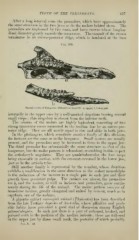Page 487 - My FlipBook
P. 487
TEETH OF THE VERTEBRATA. 497
After a long interval come the premolars, which have approximately
the same structure in the two jaws as do the molars behind them. The
premolars are implanted by two roots, and have crowns whose longitu-
dinal diameter greatly exceeds the transverse. The summit of the crown
terminates in an antero-posterior ridge, which is bordered at the base
Fig. 269.
Dental Series of Kangaroo ( Halmaturns bennetti) : a, upper, fe, lower jaw.
internally in the upper ones by a well-marked cingulura bearing several
small cusps ; this cingulum is absent from the inferior teeth.
The crowns of the molars are highly lophodont, consisting of two
strong transverse crests connected in the median line by an antero-]:>os-
terior ridge. Tliey are all nearly equal in size and alike in both jaws.
In the phalangers, which constitute another iamily of this division,
the incisors are the same as in the kangaroo. Small canines are usually
present, and the premolars may be increased to three in the upper jaw.
The third premolar has substantially the same structure as that of the
kangaroos, but the molar pattern is selenodont, resembling in this resjjcct
the artiodactyle ungulates. They are quadritubercular, the four cusps
being crescentic in section, with the crescents reversed in the lower jaw,
just as in the artiodactyles.
Still another family is represented by the wombat, whose dentition
exhibits a modification in the same direction as the rodent monodelphs
in the reduction of the incisors to a single pair in each jaw and their
growth from persistent pulps. The canines are absent, the premolars
are ^, and the molars, as well as incisors and premolars, grow contin-
uously during the life of the animal. The molar pattern consists of
transverse laminpe, greatly elongated and united by cement, much as in
capybara, one of the rodents.
A gigantic extinct marsuj)ial animal (Thylocoleo) has been described
from the late Tertiary deposits of Australia, whose affinities and prob-
able habits have provoked a good deal of discussion among English
palaeontologists. In each jaw there is a pair of enlarged, hooked, and
pointed teeth in the position of the median incisors ; these are followed
in the upper jaw by three small teeth, the posterior of which probably
Vol. I.—32


